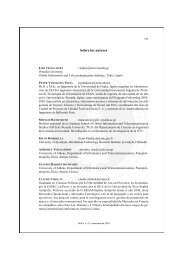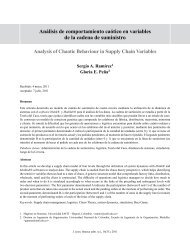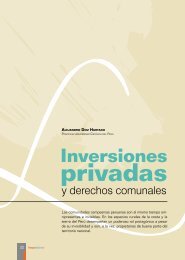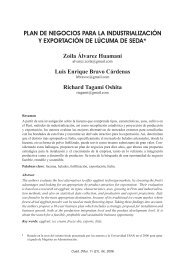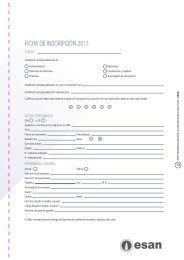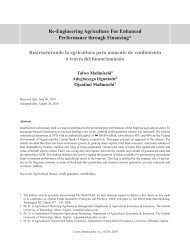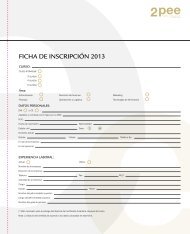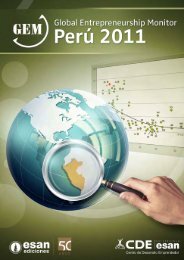El costo de capital en sectores regulados y mercados ... - Esan
El costo de capital en sectores regulados y mercados ... - Esan
El costo de capital en sectores regulados y mercados ... - Esan
Create successful ePaper yourself
Turn your PDF publications into a flip-book with our unique Google optimized e-Paper software.
2.2. Procedimi<strong>en</strong>to <strong>de</strong> estimación <strong>de</strong>l COK<br />
<strong>El</strong> método para estimar el COK mediante los betas sectoriales se basa <strong>en</strong> la<br />
estimación <strong>de</strong> los betas <strong>de</strong> cada acción <strong>de</strong>ntro <strong>de</strong> un sector <strong>en</strong> el mercado <strong>de</strong><br />
refer<strong>en</strong>cia, y compr<strong>en</strong><strong>de</strong> el sigui<strong>en</strong>te procedimi<strong>en</strong>to:<br />
• Estimar una tasa libre <strong>de</strong> riesgo r<br />
f<br />
.<br />
• Estimar el coefici<strong>en</strong>te β <strong>de</strong> cada acción para utilizarlo como índice <strong>de</strong><br />
riesgo ( β = medida <strong>de</strong> volatilidad <strong>de</strong> la acción con relación a una acción<br />
promedio. Acción promedio es aquella que ti<strong>en</strong><strong>de</strong> a <strong>de</strong>splazarse hacia<br />
arriba y hacia abajo <strong>en</strong> conjunción con el mercado <strong>en</strong> g<strong>en</strong>eral).<br />
• Estimar la tasa <strong>de</strong> retorno <strong>de</strong>l mercado o <strong>de</strong> la acción promedio. Designar<br />
este r<strong>en</strong>dimi<strong>en</strong>to como R<br />
m<br />
. <strong>El</strong> r<strong>en</strong>dimi<strong>en</strong>to que suele tomarse como<br />
repres<strong>en</strong>tativo <strong>de</strong>l mercado es el <strong>de</strong> S&P 500.<br />
• Estimar la tasa requerida <strong>de</strong> r<strong>en</strong>dimi<strong>en</strong>to sobre las acciones <strong>de</strong> la empresa<br />
<strong>de</strong> la sigui<strong>en</strong>te manera:<br />
Don<strong>de</strong>:<br />
K = r + β ×<br />
f<br />
( R − r )<br />
( Rm − r f<br />
) = Prima <strong>de</strong> riesgo sobre la acción promedio<br />
β = Índice <strong>de</strong>l riesgo <strong>de</strong> la acción <strong>en</strong> particular<br />
r<br />
f<br />
= Tasa libre <strong>de</strong> riesgo<br />
Para <strong>en</strong>t<strong>en</strong><strong>de</strong>r <strong>de</strong> qué activo <strong>de</strong>be prov<strong>en</strong>ir esta tasa libre <strong>de</strong> riesgo<br />
Damodaran afirma:<br />
m<br />
f<br />
To un<strong>de</strong>rstand what makes an asset risk free, let us go back to how risk is measured in<br />
finance. Investors who buy assets have a return that they expect to make over the time<br />
horizon that they will hold the asset. The actual returns that they make over this holding<br />
period may by very differ<strong>en</strong>t from the expected returns, and this is where the risk comes in.<br />
Risk in finance is viewed in terms of the variance in actual returns around the expected<br />
return. For an investm<strong>en</strong>t to be risk free in this <strong>en</strong>vironm<strong>en</strong>t, th<strong>en</strong>, the actual returns<br />
should always be equal to the expected return. […]<br />
[…]The only securities that have a chance of being risk free are governm<strong>en</strong>t securities, not<br />
because governm<strong>en</strong>ts are better run than corporations, but because they control the<br />
printing of curr<strong>en</strong>cy. At least in nominal terms, they should be able to fulfill their promises.<br />
Ev<strong>en</strong> this assumption, straightforward though it might seem, does not always hold up,<br />
especially wh<strong>en</strong> governm<strong>en</strong>ts refuse to honor claims ma<strong>de</strong> by previous regimes and wh<strong>en</strong><br />
they borrow in curr<strong>en</strong>cies other than their own. (Damodaran, 1998b:154)<br />
Para obt<strong>en</strong>er la tasa libre <strong>de</strong> riesgo, se obti<strong>en</strong>e un promedio histórico <strong>de</strong> los<br />
retornos <strong>de</strong> los bonos <strong>de</strong>l tesoro americano. Se consi<strong>de</strong>ra que éste <strong>de</strong>be ser un<br />
promedio aritmético; sin embargo otros autores como Damodaran opinan lo<br />
contrario, pues recomi<strong>en</strong>dan el uso <strong>de</strong> un promedio geométrico:<br />
15



